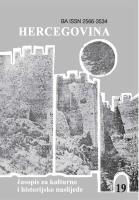Mostar - dekonstrukcija urbanog centra Hercegovine
MOSTAR - DECONSTRUCTION OF THE URBAN CENTER OF HERZEGOVINA
Author(s): Dario TerzićSubject(s): Architecture, Communication studies, Social Theory, Rural and urban sociology, Sociology of Culture
Published by: Fakultet humanističkih nauka, Univerzitet »Džemal Bijedić« u Mostaru
Keywords: Mostar; Herzegovina;divided cities; urban areas; communication; conflict; deconstruction;
Summary/Abstract: Cities have become a place where the waste of globalization is dumped, forcing us to increasingly look for local solutions to global processes. Cities thus become battlefields, laboratories. For centuries, cities have been protected by their walls, and over time a certain culture of the gate was created, and thus a certain protocol of behavior and interaction. Ethnicity has become a dominant role in conflicts and in urban wars for space and the use of space, and it is absurd that in the era of globalization such conflicts appear that delimit the territory. A new unusual mode of conflict, not to mention warfare, is awakening in divided cities such as Glasgow, Belfast, Mostar. Over time, “cities of icons” are created - Sarajevo, Mostar, Grozny, Mogadishu, Beirut. The city is a battlefield, it is a jungle to be conquered, and at the same time from which one wants to escape. We are afraid of the unknown,of the different - whether it is an individual or a group. That fear exists, and it is evident.Until the war, Catholicism, Orthodoxy and Islam were almost equally represented in Mostar. That balance has long since been lost. Before the war, Mostar was equally important for all parts of Herzegovina. We cannot view space not only as a dwelling machine but also as a way of thinking, as a territory. Divided cities must rediscover their spaces, places of communication, exchanges.
Journal: Hercegovina
- Issue Year: 2020
- Issue No: 19
- Page Range: 109-120
- Page Count: 12
- Language: Bosnian

